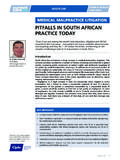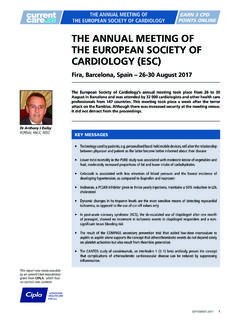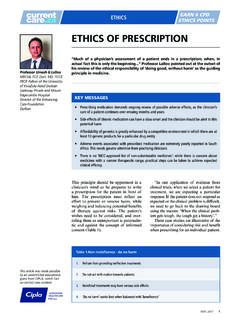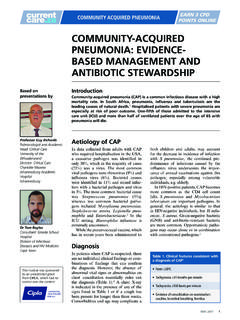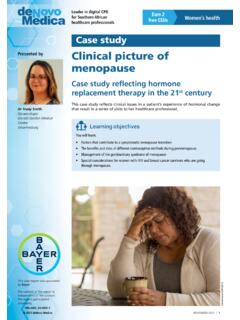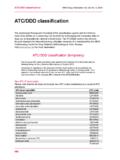Transcription of SGLT-2 inhibiTorS: a perSpecTive on SafeTy and …
1 1earn 3 cpd poinTS onLineSGLT-2 inhibiTorSJanuary 2018 SGLT-2 inhibitors : a perSpecTive on SafeTy and tolerability KEY MESSAGES Dapagliflozin is a new sodium glucose co- transporter -2 ( SGLT-2 ) inhibitor for the treatment of type 2 diabetes It improves glycaemic control and is associated with additional beneficial effects, including a modest reduction in blood pressure, weight loss, low risk of hypoglycaemia and reduction in cardiovascular events Adverse renal effects of dapagliflozin have not been demonstrated, but because pharmacokinetics are altered by renal function, dapagliflozin is contraindicated in patients with an estimated glomerular filtration rate <60ml/min Adverse events related to volume depletion are uncommon in general, but are more likely to occur in patients 65 years of age.
2 If they do occur, most are related to hypovolaemia, are mild/moderate and do not require dose interruption or discontinuation Dapagliflozin is well tolerated in older individuals aged 75 years Type 2 diabetes is associated with an increased risk of non-sexually transmitted genital infections and SGLT-2 inhibitors increase this risk. Infections are usually responsive to the usual therapies. Patients should be warned about the risk and educated to be vigilant for symptoms, and to seek treatment if an infection occurs In patients with type 2 diabetes, diabetic ketoacidosis is a very rare adverse effect associated with SGLT-2 inhibitors . The risk can be minimised by careful patient selection and careful monitoring of patients at high risk.
3 The sodium glucose co- transporter -2 ( SGLT-2 ) inhibitors (dapagliflozin, empa-gliflozin and canagliflozin) are a new class of drugs for the treatment of type 2 dia-betes that has recently been introduced in South Africa. Inhibition of SGLT-2 increases renal glucose excretion in pro-portion to the amount of filtered glu-cose, which is, in turn, determined by the plasma glucose concentration and glo-merular filtration rate (GFR). By block-ing the action of SGLT-2 , the SGLT-2 inhibitors promote glucose excretion and lower the renal threshold so that urinary glucose excretion occurs at a lower plasma glucose concentration. Because the mechanism of action of the SGLT-2 inhibitors is independent of insulin and their effect diminishes as plasma glucose concentrations decrease, they are associated with a low risk of hypoglycaemia.
4 Furthermore, caloric loss associated with increased glucose excre-tion leads to a reduction in body weight and fat mass, and because SGLT-2 inhibi-tors have a mild diuretic effect, they are associated with a modest reduction in blood ,2 Large randomised clinical trials and observational studies have shown that the SGLT-2 inhibitors are associated with a significant reduction in cardiovascular (CV) outcomes in patients with type 2 diabetes and this benefit is likely to be a class report was made possible by an unrestricted educational grant from AstraZeneca. The content of the report is independent of the inhibiTorS2 January 2018earn 3 cpd points on Accredited CPD modules .dapagliflozinIn October 2017, dapagliflozin was the first SGLT-2 inhibitor to become avail-able in South Africa for the treatment of type 2 diabetes.
5 Its efficacy and SafeTy have been well established in clinical studies in combination with metformin, a sulpho-nylurea, thiazolidinedione, a dipeptidyl peptidase-4 (DPP-4) inhibitor (with and without metformin) and insulin. In these studies it was associated with significant reductions in HbA1c, and in fasting and postprandial glucose , an average of 2-4kg weight loss and a modest reduction in sys-tolic blood ,10 SafeTy of SGLT-2 inhibitorsBecause the SGLT-2 inhibitors are a new class of treatment with a novel mecha-nism of action, their SafeTy is of specific interest to medical practitioners. In gen-eral they have been shown to be well tol-erated, without major SafeTy concerns. However some adverse events, especially those related to the mechanism of action, including genital and urinary tract infec-tions (UTIs), and urinary frequency, may be common.
6 In addition, concern over more serious adverse events emerging from early study results, some of which have not been confirmed by further stud-ies and meta-analyses, nevertheless have resulted in the inclusion of warning and precautionary notes in the individual package ,10-18 The following is a brief overview of current understand-ing of the SafeTy and tolerability of these drugs, with special emphasis on the SafeTy of safetySGLT-2 inhibition increases glucose excretion by reducing its reabsorption in the proximal convoluted tubule of the kidney. The glomerulus is not involved, therefore sparing it from damage related to increased glucose load in that part of the nephron. Clinical trials of dapagliflo-zin have not demonstrated any adverse effects on renal function.
7 Similar to that seen in clinical trials with empagliflozin, dapagliflozin was associated with an ini-tial decline in estimated GFR (eGFR) at week one (approximately -4ml/min), fol-lowed by a return towards baseline levels over 24 weeks that remained stable to week 102. Overall, over two years treatment with dapagliflozin, there was no evidence of new or worsening renal impairment, acute nephrotoxicity or progression of diabetic ,14,19 In a four-year comparison with glipizide, patients treated with dapagliflozin showed no con-sistent change in mean eGFR, and values were above baseline at final The reversible decrease in eGFR may be a beneficial effect related to transient changes in tubular-glomerular feedback mechanisms (causing renal glomerular afferent vasoconstriction)
8 , renal haemo-dynamics and intraglomerular pressure, resulting from diuresis, restricted reab-sorption of sodium and reduction in blood ,20 Indeed, in the EMPA-REG OUTCOME study, in comparison to placebo, empagliflozin was associ-ated with a 39% reduction in incident or worsening nephropathy and slowed the expected natural progression of renal pharmacokinetics of dapagliflozin are affected by renal function. Although drug exposure is increased in patients with impaired renal function, the benefi-cial effects decline with increasing renal impairment. The drug should not be initiated in patients with moderate and severe renal impairment with an eGFR <60ml/min, with end-stage renal failure or patients on depletionLike the other SGLT-2 inhibitors , dapa-gliflozin causes glycosuria, which is asso-ciated with a mild osmotic diuretic effect that is limited to the kidney.
9 It is therefore unlike other osmotic diuretics such as mannitol, which increases osmotic pres-sure in blood vessels and therefore exerts an effect throughout all body tissues. This SGLT-2 inhibiTorS3 January 2018earn 3 cpd points on Accredited CPD modules .diuresis is associated with small increases in urine volume of approximately 300-400ml per day over basal levels of , approximately half to one-third that which would be expected with a thiazide or loop ,22 In an other-wise healthy patient with type 2 diabetes, normal responses, including thirst and secretion of antidiuretic hormone, would compensate for this effect and dehydra-tion is unlikely to occur. Nevertheless, there is a theoretical potential for volume depletion in susceptible patients.
10 In clinical studies of the SGLT-2 inhibitors , the incidence of volume deple-tion was low (approximately 2-3 per 100 patient years with empagliflozin and cana-gliflozin). In a pooled analysis of SafeTy data from phase IIb/III clinical trials with dapagliflozin, the incidence of adverse events related to volume depletion (hypo-tension, hypovolaemia or dehydration) was with dapagliflozin and with placebo. In both groups, half of the adverse events occurred by week eight of treatment. In patients treated with dapa-gliflozin, hypovolaemia-related adverse events were more common in patients 65 years of age, those on concurrent treat-ment with a loop diuretic ( increase in risk) and patients with an eGFR 30-60 ml/min. The most common adverse event related to hypovolaemia was hypotension, but most events were considered unre-lated to study drug, were mild/moderate in intensity and did not require dose inter-ruption or In studies of up to 104 weeks duration, adverse events of polyuria were reported in 4% and of patients receiving dapagliflozin and placebo, respectively.
